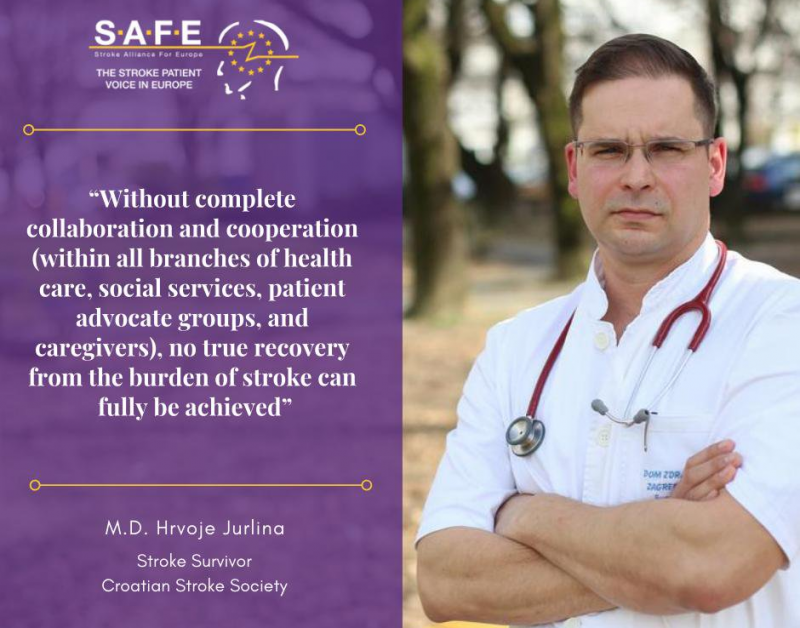
May 27, 2019
This article was first published on ScienceDaily.com
Although the occurrence of first-ever ischemic stroke (strokes due to a blood clot that blocks a blood vessel in the brain) at middle age has been decreasing over time, researchers have found that the decline is not as steep as seen in older adults.
The risk for stroke at midlife declined by approximately 39 percent, while risk of stroke at older age declined by 53 percent, when comparing a recent time period (1998-2005) to a previous time period (1962-67).
“Most strokes at midlife were due to diseases of the arteries (atherosclerosis) caused by a clot migrating from the heart. We also looked at vascular risk factors, such as hypertension and smoking, which have been declining among both age groups over time,” explained corresponding author Hugo J. Aparicio, MD, MPH, assistant professor of neurology at Boston University School of Medicine.
The researchers studied trends in the rate of ischemic stroke among two age groups in the Framingham Heart Study: middle age-35-55 years old and older age-above 55 years old. They estimated the rate of stroke occurring in four time periods, 1962-67, 1971-76, 1987-1991 and 1998-2005. They also looked at risk for stroke calculated using the Framingham Stroke Risk Profile, which gives an estimate for how likely a stroke will occur over the ensuing 10 years.
You can read the full article here.
Image source: Pixabay.com

May 25, 2019
The 5th European Stroke Organisation Conference (ESOC), took place in Milan, Italy, from 22 to 24 May 2019.
ESOC 2019 was attended by more than 5,600 participants from all over the world. Stroke Alliance for Europe had a stand at this important event, providing information on the latest stroke advocacy activities.
One of the highlights of ESOC 2019 was the constitution of the Steering Committee for the “Stroke Action Plan for Europe 2018-2030” implementation, in which SAFE will take active participation, representing the voice of stroke patients from 33 European countries.
SAFE promoted the Stroke Action Plan on its stand, now available in additional seven European languages (French, Polish, Spanish, Portuguese, Russian, Ukrainian and Greek) with many more translations to come. The Stroke Action Plan’s translation will increase its reach throughout Europe and significantly help stroke support organisations in with their further advocacy work.
Two of the SAFE Board members, Anita Arsovska from North Macedonia and Hariklia Proios from Greece held important lectures as part of ESOC Scientific Programme. SAFE’s President, Jon Barrick, co-chaired a session on the last days of the congress, covering the topic of the burden of stroke in Europe and the Life After Stroke issues.
Apart from the Board members, other SAFE organisations’ members from Turkey, Italy, Croatia, Hungary, Portugal and many other countries took active part in the ESOC 2019 programme within their fields of expertise.
Video credits: Turkish Stroke Support Organisation BEYINDER.

May 24, 2019
“For stroke survivors the real battle begins after they have been discharged from the hospital. The bio-psycho-social burden on any society (family unit), if they are not properly prepared or organized, can very quickly become devastating” said Hrvoje Jurlina, M.D., stroke survivor from Croatian Stroke Society.
SAFE: What is one issue related to the life after stroke in your country that you think needs special attention?
HJ: As in every country the healthcare system has its flaws. The root to a great percentage of these imperfections within the healthcare system lies in the lack of logistical coordination within the system itself. For example: ”If a bus driver does not know his own bus root how can anyone on board the bus be expected to arrive successfully to their desired destination?” (The Bus symbolizes Stroke, the bus driver represents the healthcare system, the bus route substitute as ‘Life after Stroke’, the bus stops depict the specific levels of care, therapy, and rehabilitation the stroke survivor must go through, and the desired destination of the stroke survivor within that bus route represents the desired level of recovery from the burden of stroke.) This is very much so the situation in many healthcare systems in regards to stroke patients. Once the stroke survivor is released from the hospital , the stroke survivor and their primary caregiver (”get on that bus”) are given very little if any information regarding post hospital recovery procedures and care options. The information given is most often very superficial and lacks a realistic picture of what awaits the stroke survivor and their primary caregiver in the immediate and distant future.
SAFE: What would be the solution, i.e. what is your organisation’s position regarding this issue?
HJ: The need for some form of standardized criteria regarding recovery, care options as well as an insight into patient rights for stroke survivors and their primary caregivers is thoroughly needed. ‘ The bus route must be laid out, all of the bus stops must be clearly marked so that the stroke survivor as well as their primary caregiver may successfully navigate and reach their desired destination, which is the recovery from the burden of stroke. To achieve these goals a firm foundation must be put in place in which an alliance of all parties involved in the stroke survivors rehabilitation and recovery can come together in order to maximize a successful post stroke outcome. Without complete collaboration and cooperation (within all branches of health care, social services, patient advocate groups, and the stroke survivors primary caregiver) no true recovery from the burden of stroke can fully be achieved. This continuous burden not only inhibits all aspects of the stroke survivors life but directly influences the lives of their family members and society as a whole.
SAFE: Please tell us more about your organisation.
HJ: Croatian Stroke Society (Hrvatsko društvo za prevenciju moždanog udara) was founded in 1997 with the aim to prevent stroke among persons at risk and stroke survivors, and to improve diagnostics, treatment and rehabilitation, based on the latest scientific knowledge. Raising the stroke awareness in Croatia, which will lead to the reduction of stroke by creating a healthier and more conscious society, is our vision. The Croatian Stroke Society is divided into two branches which are collaborating – stroke survivors section and professional/scientific section. Our activities are focused at educating the population, stroke survivors, caregivers and the medical staff about stroke to improve diagnosis, treatment and rehabilitation. The stroke survivors section members are primarily involved on raising the stoke awareness among the population including stroke survivors and their family and caregivers organizing public campaigns, patient groups, lectures with stroke risk assessments, activities on social media channels, etc. The professional/scientific section members are primarily involved on raising the stroke awareness and education of health professionals as well as providing the medical scientific background to the public and stroke survivors. Croatian Stroke Society is proud member of the Stroke Alliance for Europe, European Stroke Organization and Central and Eastern European Stroke Society.

May 20, 2019
This article was first published on ScienceDaily.com
A new study from the University of Eastern Finland shows that a moderately high intake of dietary cholesterol or consumption of up to one egg per day is not associated with an elevated risk of stroke. Furthermore, no association was found in carriers of the APOE4 phenotype, which affects cholesterol metabolism and is remarkably common among the Finnish population. The findings were published in the American Journal of Clinical Nutrition.
Findings from earlier studies addressing the association of dietary cholesterol or egg intake with the risk of stroke have been contradictory. Some studies have found an association between high dietary cholesterol intake and an increased risk of stroke, while others have associated the consumption of eggs, which are high in cholesterol, with a reduced risk of stroke. For most people, dietary cholesterol plays a very small role in affecting their serum cholesterol levels. However, in carriers of the apolipoprotein E phenotype 4 — which significantly impacts cholesterol metabolism — the effect of dietary cholesterol on serum cholesterol levels is greater. In Finland, the prevalence of APOE4, which is a hereditary variant, is exceptionally high, with approximately one third of the population presenting as carriers. Yet, research data on the association between a high intake of dietary cholesterol and the risk of stroke in this population group has not been available until now.
The dietary habits of 1,950 men aged between 42 and 60 years with no baseline diagnosis of a cardiovascular disease were assessed at the onset the Kuopio Ischaemic Heart Disease Risk Factor Study, KIHD, in 1984-1989 at the University of Eastern Finland. APOE phenotype data were available for 1,015 of the men participating in the study. Of those, 32% were known carriers of APOE4.
During a follow-up of 21 years, 217 men were diagnosed with stroke. The study found that neither dietary cholesterol nor egg consumption was associated with the risk of stroke — not even in carriers of APOE4.
The findings suggest that moderate cholesterol intake or daily egg consumption are not associated with the risk of stroke, even in persons who are genetically predisposed to a greater effect of dietary cholesterol on serum cholesterol levels. In the highest control group, the study participants had an average daily dietary cholesterol intake of 520 mg and they consumed an average of one egg per day, which means that the findings cannot be generalised beyond these levels. One egg contains approximately 200 mg of cholesterol. In this study, about a fourth of the total dietary cholesterol consumed came from eggs. Furthermore, the generalisability of this study is also weakened by the fact that the study population did not have a pre-existing cardiovascular disease at baseline and the size of the study population was relatively small. Therefore, the findings of the study should be verified in a larger cohort as well as in people with a pre-existing cardiovascular disease, who are currently advised to limit their intake of cholesterol and eggs.
Story Source: University of Eastern Finland. “Dietary cholesterol or egg consumption do not increase the risk of stroke, Finnish study finds.” ScienceDaily. ScienceDaily, 20 May 2019. <www.sciencedaily.com/releases/2019/05/190520093448.htm>.

May 18, 2019
“Having attended the SAFE Regional Conference in Paris, I was struck by the need for us as stroke survivors to look past our own borders and countries and to focus on what can be done to ensure that the EU Institutions recognise the burden of stroke across Europe on survivors, their carers and families, and the need for stoke to be recognised as its own incredibly important entity, rather than diluting it in the wider classification of cardiovascular diseases” said Martin Quinn, stroke survivor from Ireland.
We at SAFE are thankful for Martin’s feedback and subsequent engagement after the SAFE Regional Conference in Paris. Sharing his views and actions in the blog post below, we hope to inspire other SAFE members from across Europe, just ahead of the upcoming EU elections, to be held between 23 and 26 May 2019.
“My thoughts after the Paris Conference were filled on what I could do as a stroke survivor to further this discussion and the recognition required on the burden of stroke across Europe. I felt that it was important that I should play my part as a stroke survivor from Tipperary in Ireland and that perhaps I could influence the process in some way and be a voice for those survivors that had no voice in the ongoing battle against stroke.
I am the type of person with the attitude of Benjamin Franklin who once said, “Don’t put off until tomorrow what you can do today”, so immediately on returning home from Paris I put pen to paper and wrote to my local media about my attendance at the Conference; on the implementation of the Stroke Action Plan for Europe, on the event held under the patronage of the Romanian Presidency of the Council of the European Union on the role of policy in tackling stroke which took place in Brussels, and on ongoing stroke support organisation activity across Europe.
The local media immediately picked up on the story and ran articles in the local newspapers and I was interviewed about the Conference on two local radio stations. There has been much positive reaction to this story and it has been widely shared amongst stroke survivors and their organisations.
With impending European Elections I wanted also to get this message out to outgoing Irish Members of the European Parliament and to candidates contesting the elections for the first time. So I again put pen to paper and wrote to every Irish MEP and to first time candidates that I could get contact details for. In my letter to them I informed them of my attendance at the Paris Conference and of SAFE’s goal to decrease the number of strokes in Europe by advocating for better prevention, access to adequate treatment, post-stroke care and rehabilitation. I went on to refer to the Brussels event, which was held under the patronage of the Romanian Presidency of the Council of the European Union, and I attached the report from the event for their consideration. In my letter I said that for me as a stroke survivor it was very important to hear of patient representatives and clinical experts calling on the EU Institutions to recognise the burden of stroke as its own incredibly important entity, rather than diluting it in the wider classification of cardiovascular diseases, and on the request to the EU to facilitate discussions between its Member States on the implementation of the Stroke Action Plan for Europe. I concluded by saying that joining forces with EU policy-makers to address the burden of stroke that stroke survivors, their families and the overall society are currently facing is essential, as is the support of our MEP’s in the implementation of the Stroke Action Plan for Europe.
As luck would have it on the day of one of my interviews on my local radio station, who should I meet in the studio corridor only Deirdre Clune, Fine Gael MEP for Ireland South (Member of EPP Group in Parliament). I was previously acquainted with Ms. Clune so having exchanged pleasantries I then had a brief word with her about my correspondence to her on the Stroke Action Plan for Europe and I then headed into studio for my own interview. Later on however I had a further opportunity to meet Ms. Clune and to speak to her in more detail on the matter. She thanked me for my correspondence and for sending her a copy of the Brussels report and she committed if elected to following through on the proposals and objectives as outlined in the report to further the implementation of the Stroke Action Plan for Europe.
Further support for the implementation of the Stroke Action Plan for Europe has been forthcoming to me in response to my letter to candidates from Ireland South Fianna Fáil candidate Billy Kelleher (ALDE Group in Parliament), from Ireland South Labour candidate Sheila Nunan (PES Group in Parliament) and from Dublin Independent Socialist candidate Clare Daly.
Sheila Nunan submitted a detailed response stating that she would call for the full implementation of the UN Convention on the Rights of Persons with Disabilities, including stroke survivors at EU level and will work with disability organisations and organisations like SAFE & IHF to achieve this. She added that she will promote and support new measures to ensure that all stroke survivors have access to inclusive education, with personalised supports, and an inclusive workplace.
The Ireland South Green Party candidate, Grace O’Sullivan (Greens/EFA Group in Parliament), said that she would keep my letter and report attachment on file for review should she be successful in getting elected.
I eagerly await responses from the others!” concluded Mr. Quinn.
<Featured Photo: Martin Quinn meets Ms. Deirdre Clune; Credits: Martin Quinn>









